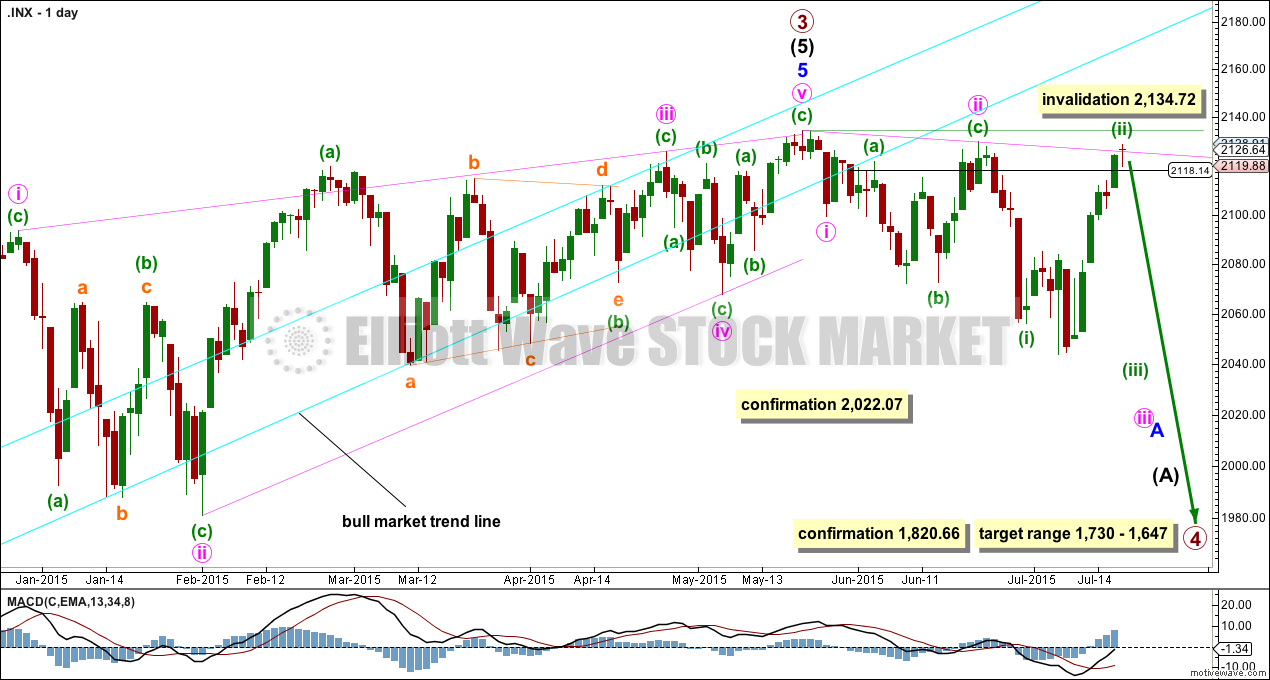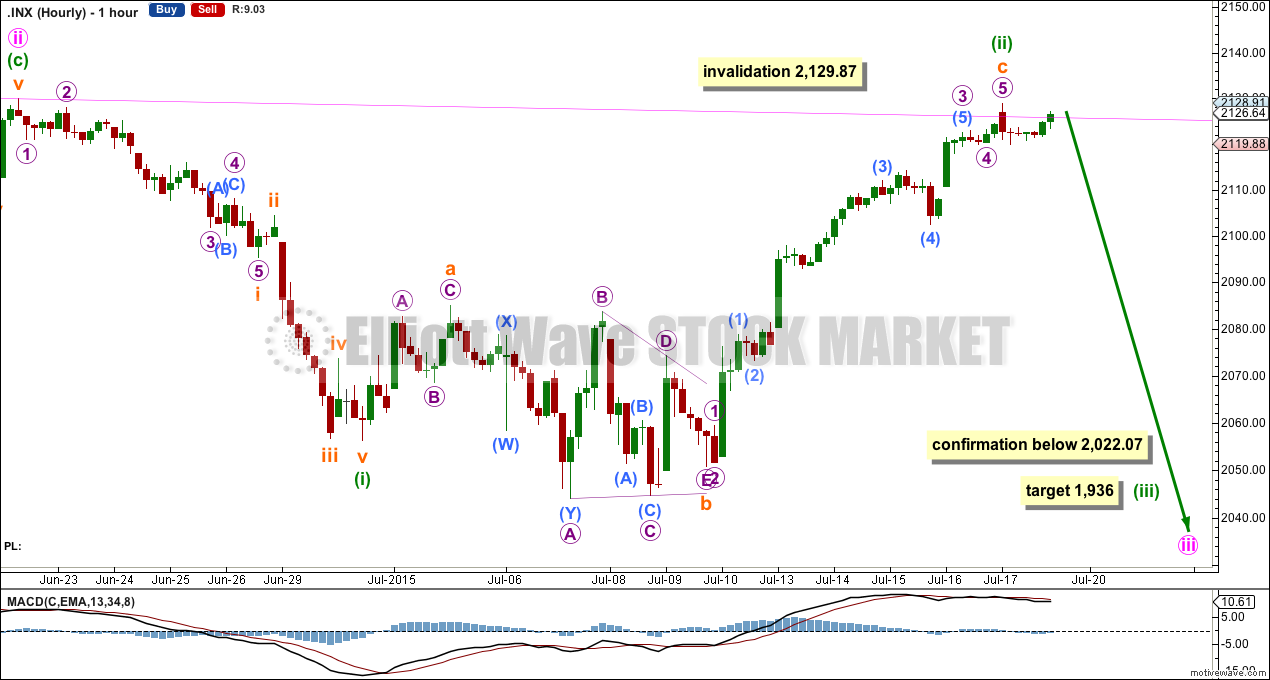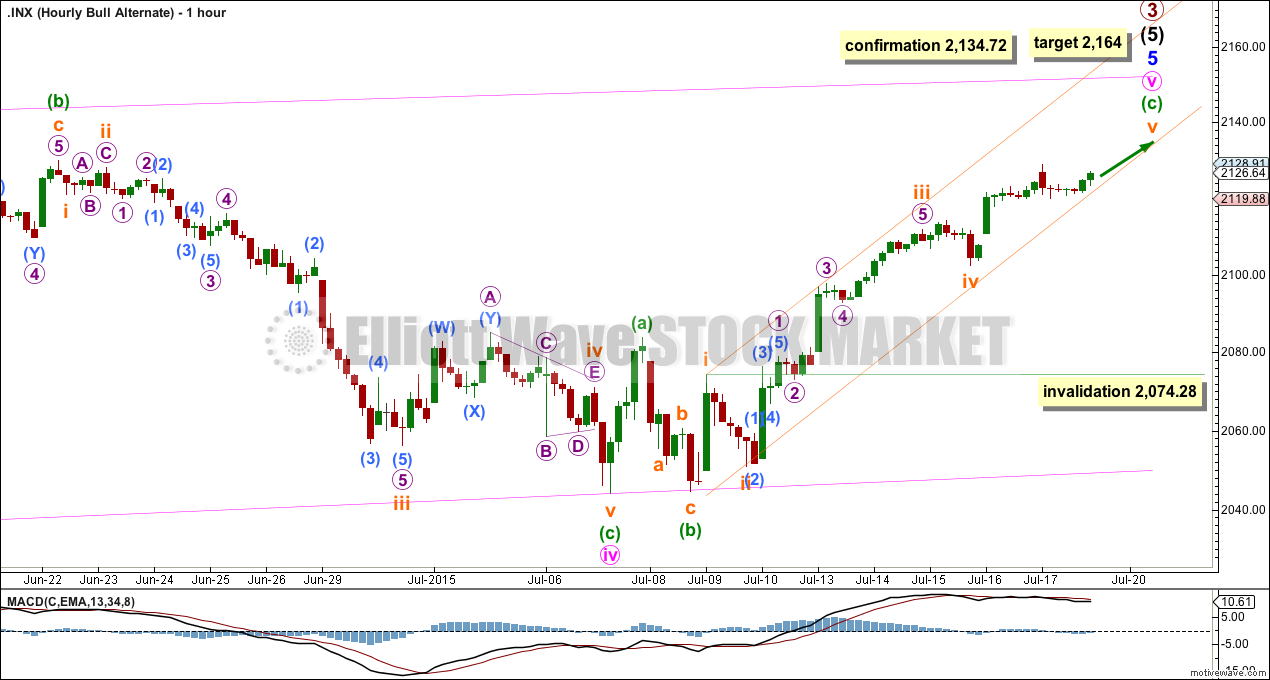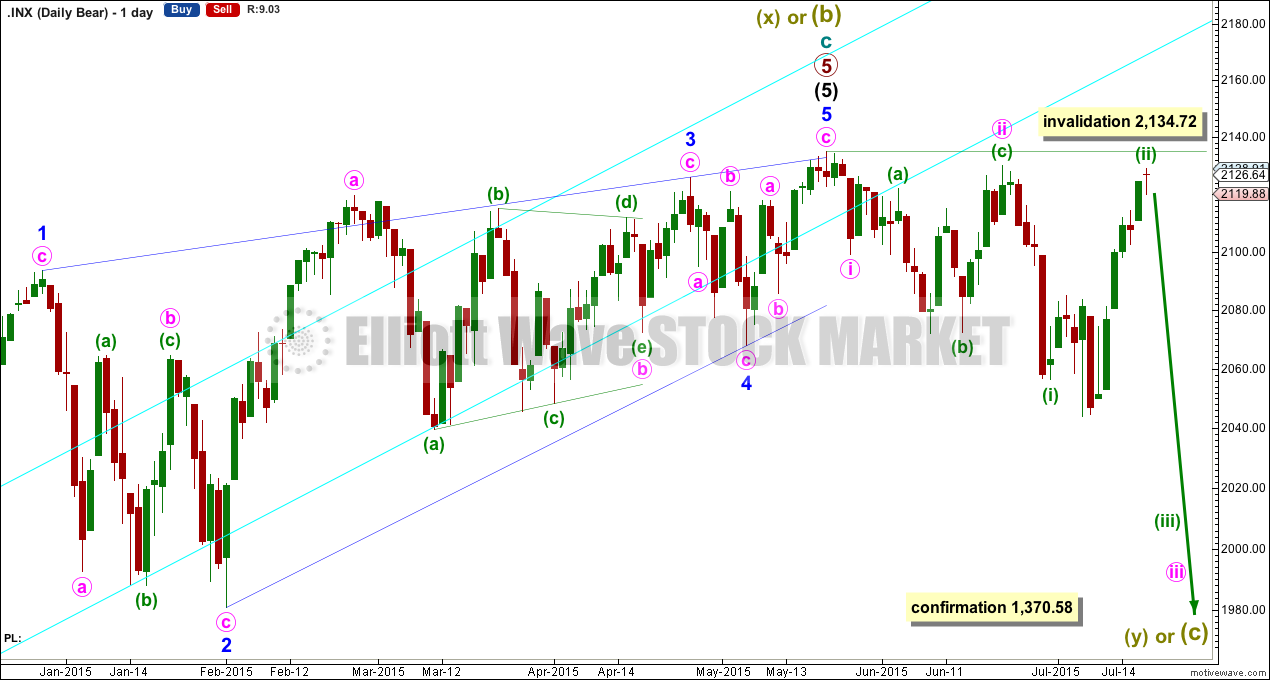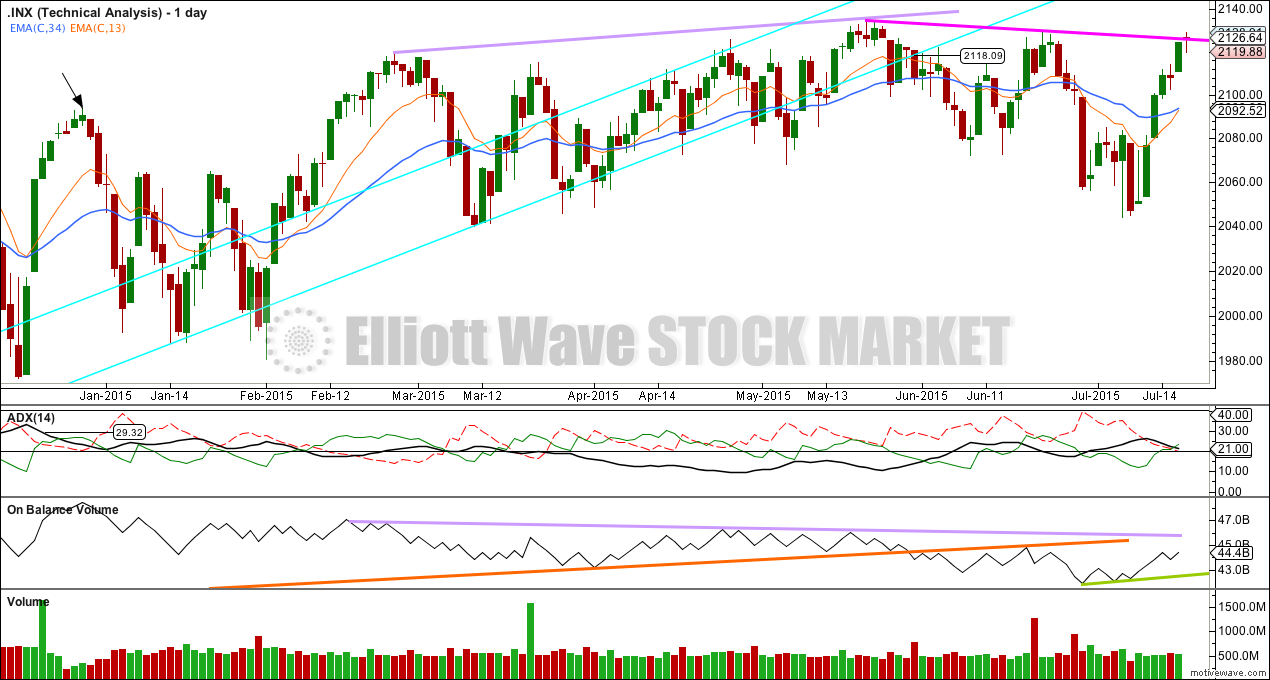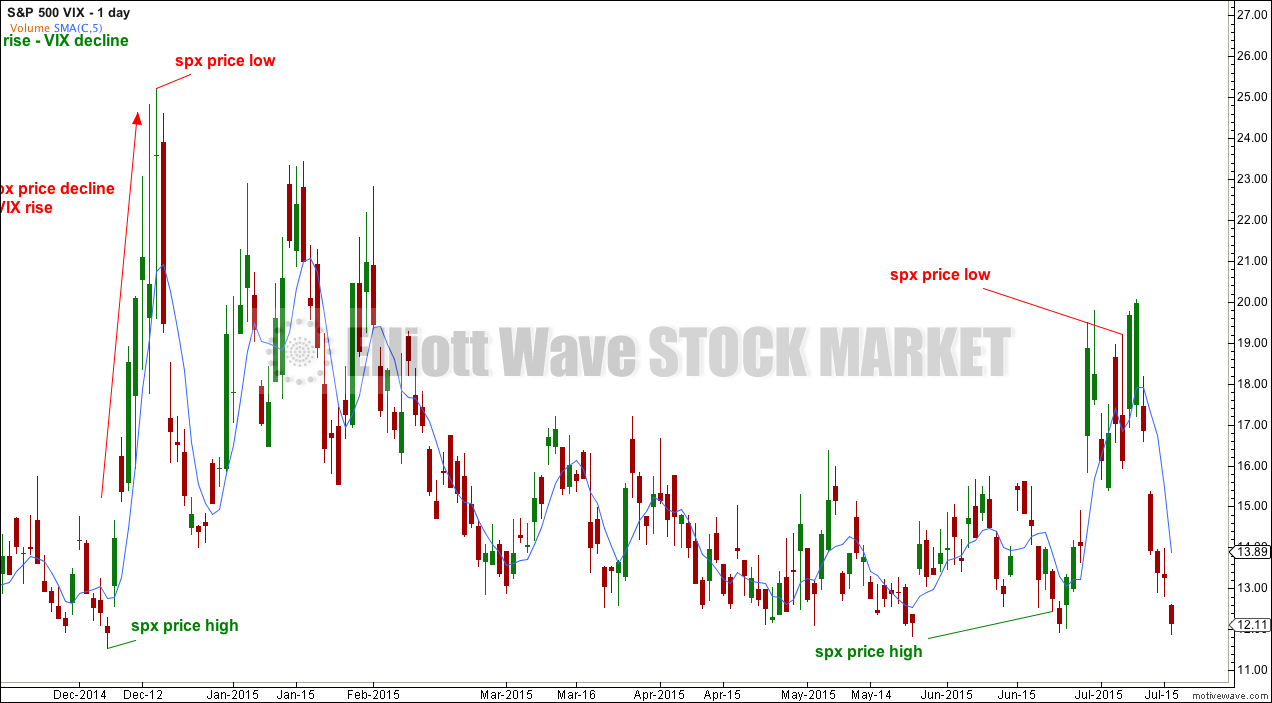Upwards movement continued, which was not expected for the main Elliott wave count.
However, price has remained below the invalidation point, but is now slightly breaching the upper trend line which was expected to provide resistance.
Summary: The main wave count still expects a strong third wave down. The target is now at 1,936. I am concerned though that the structure on the five minute chart indicates there may yet be more upwards movement to come.
Changes to last analysis are bold.
To see a weekly chart and how to draw trend lines click here.
MAIN ELLIOTT WAVE COUNT
It is possible that the S&P has seen a primary degree (or for the bear count below a Super Cycle degree) trend change.
This wave count now has some confirmation at the daily chart level with a close more than 3% of market value below the long held bull market trend line.
Further confirmation would come with:
1. A new low below 2,022.07 to invalidate the alternate wave count.
2. A clear five down on the hourly chart.
3. A clear five down on the daily chart.
4. A new low below 1,820.66.
5. A break below the 50 day SMA on the weekly chart.
As each condition is met the probability of a substantial trend change would increase.
At this stage, a trend change is looking somewhat likely so I’ll list points in its favour:
1. ADX is above 20 and rising, and the -DX line is above the +DX line indicating a new downwards trend.
2. The long held bull market trend line, the strongest piece of technical analysis on ALL charts, has been breached now by a close more than 3% of market value.
3. There is quadruple negative divergence between price and MACD on the weekly chart.
4. There is double negative divergence between price and MACD on the daily chart.
5. There is persistent and strong negative divergence between price and RSI on the monthly chart. The last time this happened was October 2007 and we all know what happened after that…
6. A long held bull trend line on On Balance Volume going back to October 2014 has been breached and is no longer providing support (orange line added to OBV on the TA chart below). It may provide resistance.
7. DJT has recently failed to confirm the continuation of a bull market. This does not indicate a bear market, but does indicate caution.
Primary wave 4 would be likely to end within the price territory of the fourth wave of one lesser degree: intermediate wave (4) has its price territory from 1,730 to 1,647.
Primary wave 4 would be likely to exhibit alternation to primary wave 2. Primary wave 2 was a 0.41 zigzag correction lasting 12 weeks, one short of a Fibonacci 13. Primary wave 4 may be more shallow than the 0.382 Fibonacci ratio, and may be a flat, combination or triangle, which are more time consuming structures than zigzags so it should be longer in duration than primary wave 2. Primary wave 4 may last a Fibonacci 21 weeks in total, 1.618 the duration of primary wave 2.
MAIN HOURLY WAVE COUNT
Minuette wave (ii) may have continued a little higher, and so far is just below the invalidation point.
Subminuette wave c is now just 2.86 points longer than 2.618 the length of subminuette wave a.
However, on the five minute chart, the small wave down after the high subdivides as a three wave structure indicating this upwards movement may still not be over.
If minuette wave (ii) moves any higher, then it may not move beyond the start of minuette wave (i) above 2,129.87.
If minuette wave (ii) is over, then at 1,936 minuette wave (iii) would reach 2.618 the length of minuette wave (i).
If price moves above 2,129.87 on Monday, I would use the alternate hourly wave count below.
ALTERNATE ELLIOTT WAVE COUNT
The ending contracting diagonal may still be incomplete. Ending diagonals require all sub waves to subdivide as zigzags, and the fourth wave should overlap first wave price territory. It is Elliott wave convention to always draw the diagonal trend lines to indicate a diagonal structure is expected.
The diagonal trend lines are no longer clearly contracting and minuette wave (c) within minute wave iv now looks like a three where it should be a five. This reduces the probability of this wave count.
If it moves any lower, then minute wave iv may not be longer than equality in length with minute wave ii at 2,022.07. If it is over here, then minute wave v up also has a limit and may not be longer than equality with minute wave iii at 2,197.84.
The best way to see where and when upwards movement may end is the upper diagonal i-iii trend line. It is very likely to be overshot. Upwards movement may find resistance at the long held bull market trend line.
Because the long held bull market trend line has now been breached by a close more than 3% of market value below it, this wave count is now an alternate and a bear market is indicated.
Minute wave v must subdivide as a zigzag, and within it, minuette waves (a) and (b) are most likely now complete. Within minuette wave (c), subminuette waves i, ii and now iii may be complete. Subminuette wave iv may not move into subminuette wave i price territory below 2,074.28.
Subminuette wave iv shows up on the daily chart as one small red candlestick.
At 2,164 subminuette wave v would reach equality in length with subminuette wave i.
BEAR ELLIOTT WAVE COUNT
The subdivisions within cycle waves a-b-c are seen in absolutely exactly the same way as primary waves 1-2-3 for the main wave count.
In line with recent Grand Super Cycle wave analysis, I have moved the degree of labelling for the bear wave count all up one degree.
This bear wave count expects a Super Cycle wave (c) to unfold downwards for a few years, and if it is a C wave it may be devastating. It may end well below 666.79.
However, if this wave down is a Super Cycle wave (y), then it may be a time consuming repeat of the last big flat correction with two market crashes within it, equivalent to the DotCom crash and the recent Global Financial Crisis, and it may take another 8-9 years to unfold sideways.
Within the new bear market, no second wave correction may move beyond the start of its first wave above 2,134.72.
TECHNICAL ANALYSIS
ADX is still declining indicating the market is consolidating, not trending. This slightly supports the wave count. Only slightly, because ADX does tend to be a lagging indicator.
Price has breached the pink trend line slightly.
On Balance Volume is moving higher with price; the rise in price is supported by OBV.
I have looked back at recent highs in terms of volume. There was one rise up to the high of 26th December 2014 (arrow) with a subsequent five day fall. That rise in price was not supported by volume: while price rose volume clearly declined, but On Balance Volume moved higher. The fall in price for the following five days was supported by a rise in volume, with OBV also declining. The fall in price was supported by volume, but it was a movement against the trend to a short term low. This was the opposite of what would normally be expected. Therefore, because at this time volume is providing confusing messages for the S&P 500, I am concluding that currently OBV may be a better indicator of volume, so that is what I will use primarily and will relegate volume bars to a secondary role.
This rise in price would be expected to continue from this regular TA. This TA is not in line currently with the main wave count. Price may continue to rise until OBV again comes to find resistance at its lilac trend line.
Nasdaq has made new all time highs on Friday. It is the only one of the indices (of S&P500, DJIA, DJT and Nasdaq) to have done so.
A note on Dow Theory: for the bear wave count I would wait for Dow Theory to confirm a huge market crash. For that to be confirmed the following new lows are needed:
S&P500: 1,820.66
Nasdaq: 4,116.60
DJT: 7,700.49
DJIA: 15,855.12
At this time DJT is closest, but none of these indices have made new major swing lows yet.
Vix did make a new low for 16th July. There is no negative bearish divergence between the last price high at 22nd June and this rise in price for the end of this week.
Over a longer time frame, since Dec-2014, there is some bearish convergence: VIX is making higher lows while price has made higher highs. While price is making new all time highs up to 22nd June, volatility is not quite declining to the same level; volatility is slightly higher.z
This analysis is published about 07:31 p.m. EST.

